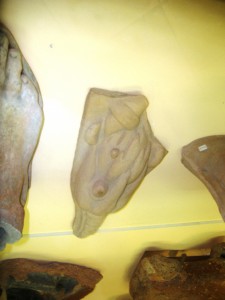Last Sunday’s outing to Cerveteri and its Etruscan necropolis included a visit to the town’s small museum. Where we saw the following terracotta figurine:

The piece wasn’t labeled, and I had to take the photograph at a weird angle through glass, so the quality is not great. But that looks like an artichoke to me, or maybe a cardoon. Unfortunately I wasn’t able to find much on the internet about the Etruscans and the artichoke, but they definitely had it. And it is still a big crop in the region. But I’m just not entirely certain. What do you think?
Nibbles: Wine, Ass, Maps, Mauka, Pest management, Photos
- Mathilda on domestication of the vine and donkey.
- New software for species mapping is out: Croziat.
- Another day, another tuber.
- Using Diversity as a Pest Management Tool. There’s a thought.
- Pix of West African plants, including cultivated, with lots of assorted link goodness.
Agrobiodiversity everywhere, if you look
My weekend reading included two pieces that I felt sure would prove well written and engaging, but which I frankly did not think would yield much in the way of agrobiodiversity fodder. Turns out I was wrong, at least on the latter point.
Felipe Fernandez-Armesto’s review of the Encyclopedia of Exploration 1850 to 1940 by Raymond John Howgego is indeed a model of its type: informative, stimulating and charming. It also includes a reference to the late nineteenth-century Swiss ethnobotanist of Paraguay Moisés Bertoni, who described Stevia rebaudiana, a controversial sugar substitute. And another to the Société Impériale Zoologique d’Acclimatation, which had a famous birthday boy as a loyal member in its early days. 1 A Colonel Henry Wayne apparently won the society’s gold medal for his efforts to introduce camels to the US.
The second piece that intrigued me over the weekend was an article by Matt Jenkins in the Smithsonian Magazine about the elite pilots who guide ships through the treacherous, sand-barred mouth of the Columbia River in Oregon. What’s the agrobiodiversity angle? Well, Portland and other upriver ports are the the main gateway in the US for its wheat and barley exports. The river pilots can shut down the entrance to the river if conditions are too bad, but, to quote one of them:
“When we shut down the bar for two days, trains are backed up all the way into the Midwest. And just like a traffic jam on the freeway, once you clear the wreck, it takes a long time for it to smooth out again.”
It’s a great image. The world’s interdependence for agricultural products 2 resting on the judgement of a dozen or so salty sea dogs in the Pacific Northwest.
Maize aguafiestas
From Jacob van Etten.
Uncorking a big bottle of agrobiodiversity, that is what Mexico’s first farmers did when they domesticated maize. Not only is maize enormously malleable, genetic diversity also goes everywhere through cross-pollination. That is in traditional farming systems. Modern maize improvement has been about sorting out this abundance by “freezing” it into breeding lines, to get some control over the diversity feast. But what happens when the hybrids are released into the dance room again?
An Italian study just out quantifies the gene flow from hybrids to traditional varieties. It finds different degrees of purity in the traditional varieties, but no genetic erosion. This is an interesting finding in the light of writings about “creolisation” in Mesoamerican agriculture. Creolisation, the mixing of modern and traditional varieties, is thought to lead to plants that combine their benefits. I have always wondered if the creolised varieties of Mesoamerica are not modern varieties “creolised” by selection instead of mixing with traditional varieties. Something similar to the Italian study would be needed to find this out.
The question is only one step removed from the issue of gene flow from transgenic crops to traditional varieties. Perhaps you remember the Quist and Chapela paper published in Nature in 2001 on the presence of transgenes in Mexican traditional maize, and the controversy it generated. A new study confirms the presence of transgenes in Mexico with an improved study design. Through genetic population simulations it also explains why detection of transgenes is erratic and prone to giving false negatives. The distribution of the transgenes is likely to be very skewed. A few fields will have much of them, but most will have very few. This has to be taken into account and therefore authors call for more rigorous sampling methods to detect transgene presence.
There is little discussion or speculation about the effects of transgenes on maize diversity. Will the transgenes just add to the existing diversity, like the hybrids in Italy? Will they perhaps produce some benefits, like the creolized varieties? Or will, in some Monty Python-like scenario, the big seed companies pick up the message about rigorous sampling and start to trace transgenes in Mexico in order to charge farmers for unlicensed use of their technology?
Nibbles: Agroforestry
- ICRAF gives Cameroon top marks for “planting the right tree in the right place.”